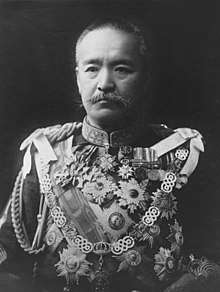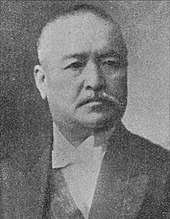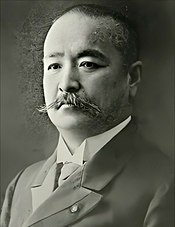Katsura Tarō
Prince Katsura Tarō (桂 太郎, 4 January 1848 – 10 October 1913) was a Japanese general within the Imperial Japanese Army, and a politician who is the second-longest serving prime minister of Japan, having served three terms from 1901 to 1906, 1908 to 1911 and 1912 to 1913.
Prince Katsura Tarō | |
|---|---|
桂 太郎 | |
 Katsura Tarō, c.early 1900s | |
| Lord Keeper of the Privy Seal of Japan | |
| In office 21 August 1912 – 21 December 1912 | |
| Monarch | Taishō |
| Preceded by | Tokudaiji Sanetsune |
| Succeeded by | Prince Fushimi Sadanaru |
| Prime Minister of Japan | |
| In office 21 December 1912 – 20 February 1913 | |
| Monarch | Taishō |
| Preceded by | Saionji Kinmochi |
| Succeeded by | Yamamoto Gonnohyōe |
| In office 14 July 1908 – 30 August 1911 | |
| Monarch | Meiji |
| Preceded by | Saionji Kinmochi |
| Succeeded by | Saionji Kinmochi |
| In office 2 June 1901 – 7 January 1906 | |
| Monarch | Meiji |
| Preceded by | Saionji Kinmochi (Acting) |
| Succeeded by | Saionji Kinmochi |
| Minister of War of the Japanese Empire | |
| In office 12 January 1898 – 23 December 1900 | |
| Monarch | Meiji |
| Preceded by | Takashima Tomonosuke |
| Succeeded by | Kodama Gentarō |
| Governor General of Taiwan | |
| In office 2 June 1896 – 14 October 1896 | |
| Monarch | Meiji |
| Preceded by | Kabayama Sukenori |
| Succeeded by | Nogi Maresuke |
| Personal details | |
| Born | 4 January 1848 Hagi, Chōshū Domain, Japan |
| Died | 10 October 1913 (aged 65) Tokyo, Japan |
| Cause of death | Stomach cancer |
| Resting place | Shōin Jinja, Setagaya, Tokyo |
| Political party | Constitutional Association of Allies (1913) |
| Other political affiliations | Independent (1896–1913) |
| Profession | Soldier and politician |
| Awards | See Decorations |
| Signature |  |
| Military service | |
| Allegiance | Empire of Japan |
| Branch/service | Imperial Japanese Army |
| Rank | General |
| Commands | IJA 3rd Division |
| Battles/wars | Boshin War First Sino-Japanese War |
Early life
Katsura was born into a samurai family from Hagi, Chōshū Domain (present day Yamaguchi Prefecture). As a youth, he joined the movement against the Tokugawa shogunate and participated in some of the major battles of the Boshin War that led to the Meiji Restoration.
Army career

The new Meiji government considered that Katsura displayed great talent, and sent him to Germany to study military science. He served as military attaché at the Japanese embassy in Germany from 1875 to 1878 and again from 1884 to 1885. On his return to Japan, he was promoted to major general. He served in several key positions within the Imperial Japanese Army, and in 1886 was appointed Vice-Minister of War.[1]
During the First Sino-Japanese War (1894–1895) Katsura commanded the IJA 3rd Division under his mentor, Field Marshal Yamagata Aritomo. During the war, his division made a memorable march in the depth of winter from the north-east shore of the Yellow Sea to Haicheng, finally occupying Niuchwang, and effecting a junction with the IJA 2nd Army which had moved up the Liaodong Peninsula.[1]
After the war, he was elevated with the title of shishaku (viscount) under the kazoku peerage system. He was appointed 2nd Governor-General of Taiwan from 2 June 1896, to October 1896.
In successive cabinets from 1898 to 1901, he served as Minister of War.
Prime Minister

Katsura Tarō served as the 11th, 13th and 15th prime minister of Japan. His position as the longest-serving prime minister of Japan (total length) was surpassed by Shinzo Abe on 20 November 2019.
First administration
Katsura became prime minister for the first time on 2 June 1901, and he retained the office for four and a half years to 7 January 1906, which was then a record in Japan.[1] Japan emerged as a major imperialist power in East Asia. In terms of foreign affairs, it was marked by the Anglo-Japanese Alliance of 1902 and victory over the Russian Empire in the Russo-Japanese War of 1904–1905. During his tenure, the Taft–Katsura agreement, accepting Japanese hegemony over Korea, was reached with the United States. Katsura received the Grand Cross of the Order of St Michael and St George from British King Edward VII and was elevated to the rank of marquess by Emperor Meiji.[1]
In terms of domestic policy, Katsura was a strictly conservative politician who attempted to distance himself from the Diet of Japan and party politics. His political views mirrored that of Yamagata Aritomo in that he viewed that his sole responsibility was to the Emperor. He vied for control of the government with the Rikken Seiyūkai, the majority party of the lower house, headed by his archrival, Marquess Saionji Kinmochi.
In January 1906, Katsura resigned the premiership to Saionji Kinmochi over the unpopular Treaty of Portsmouth (1905), ending the war between Japan and Russia. However, his resignation was part of a "back door deal," brokered by Hara Takashi to alternate power between Saionji and Hara.
On 1 April 1906, he was awarded the Grand Cordon of the Supreme Order of the Chrysanthemum.
Second administration
Katsura returned as Prime Minister from 14 July 1908, to 30 August 1911. His second term was noteworthy for the Japan–Korea Annexation Treaty of 1910. He also promulgated the Factory Act in 1911, the first act for the purpose of labor protection in Japan.
Katsura was increasingly unpopular during his second term over public perception that he was using his office to further both his personal fortune and the interests of the military (gunbatsu) over the welfare of the people. He also faced growing public dissatisfaction over the persistence of the hanbatsu domainal based politics.
After his resignation, he became a kōshaku (公爵 = prince), Lord Keeper of the Privy Seal of Japan and one of the genrō.
Third administration
Katsura's brief reappointment again as Prime Minister again from 21 December 1912, to 20 February 1913, sparked widespread riots in what became known as the Taisho Political Crisis. His appointment was viewed as a plot by the genrō to overthrow the Meiji Constitution. However, rather than compromising, Katsura created his own political party, the Rikken Dōshikai (Constitutional Association of Allies) in an effort to establish his own support base.
However, faced with a no-confidence motion, the first successful one in Japanese history, and the loss of the support of his backers, he was forced to resign in February 1913. He was succeeded by Yamamoto Gonnohyōe.
Death

Katsura died of stomach cancer eight months later on 10 October 1913, aged 65. His funeral was held at the temple of Zōjō-ji in Shiba, Tokyo and his grave is at the Shōin Jinja, in Setagaya, Tokyo.
Honors
From the corresponding article in the Japanese Wikipedia


Titles
- Viscount (20 August 1895)
- Count (27 February 1902)[2]
- Marquess (21 September 1907)
- Prince (21 April 1911)
Decorations
Japanese
- Grand Cordon of the Order of the Sacred Treasure (20 August 1895; Second Class: 11 May 1891)
- Order of the Golden Kite, 3rd class (20 August 1895)
- Grand Cordon of the Order of the Rising Sun (27 December 1901; Third Class: 19 November 1885; Fourth Class: 26 May 1880)
- Grand Cordon of the Order of the Paulownia Flowers (10 October 1913; posthumous)
- Collar of the Order of the Chrysanthemum (10 October 1913, posthumous; Grand Cordon: 1 April 1906)
Foreign
- Honorary Knight Grand Cross of the Order of the Bath (GCB) (8 July 1905)[3]
- Knight Grand Cross of the Order of Pius IX (5 June 1906)
References
-

- "Latest intelligence – Japan". The Times (36703). London. 28 February 1902. p. 3.
- The London Gazette, 14 July 1905
- Lone, Stewart (2000). Army, Empire, and Politics in Meiji Japan: The Three Careers of General Katsura Taro. Palgrave Macmillan. ISBN 0-312-23289-6.
External links
![]()
| Political offices | ||
|---|---|---|
| Preceded by Saionji Kinmochi |
Prime Minister of Japan 21 December 1912 – 20 February 1913 |
Succeeded by Yamamoto Gonnohyōe |
| Preceded by Tokudaiji Sanetsune |
Lord Keeper of the Privy Seal 21 August 1912 – 21 December 1912 |
Succeeded by Prince Fushimi Sadanaru |
| Preceded by Uchida Kosai |
Foreign Minister (acting) 21 December 1912 – 29 January 1913 |
Succeeded by Katō Takaaki |
| Preceded by Saionji Kinmochi |
Prime Minister of Japan 14 July 1908 – 30 August 1911 |
Succeeded by Saionji Kinmochi |
| Preceded by Masahisa Matsuda |
Finance Minister 14 July 1908 – 30 August 1911 |
Succeeded by Yamamoto Tatsuo |
| Preceded by Yuzuru Kubota |
Minister of Education 14 December 1905 – 7 January 1906 |
Succeeded by Saionji Kinmochi |
| Preceded by Kodama Gentarō |
Home Minister 12 October 1903 – 20 February 1904 |
Succeeded by Yoshikawa Akimasa |
| Preceded by Itō Hirobumi |
Prime Minister of Japan 2 June 1901 – 7 July 1906 |
Succeeded by Saionji Kinmochi |
| Preceded by Takashima Tomonosuke |
Minister of War 12 January 1898 – 23 December 1900 |
Succeeded by Kodama Gentarō |
| Preceded by Kabayama Sukenori |
Governor General of Taiwan 2 June 1896 – 14 October 1896 |
Succeeded by Nogi Maresuke |